Key takeaways:
- Educational toys enhance cognitive skills like problem-solving and critical thinking while fostering creativity and curiosity.
- Hands-on experiences with toys, such as science kits and collaborative games, can spark lifelong interests and social skills in children.
- Choosing age-appropriate and versatile toys is crucial for effective learning and sustaining engagement as children develop.
- Educational toys promote independence, decision-making, and emotional resilience through play, helping children navigate their feelings and grow.
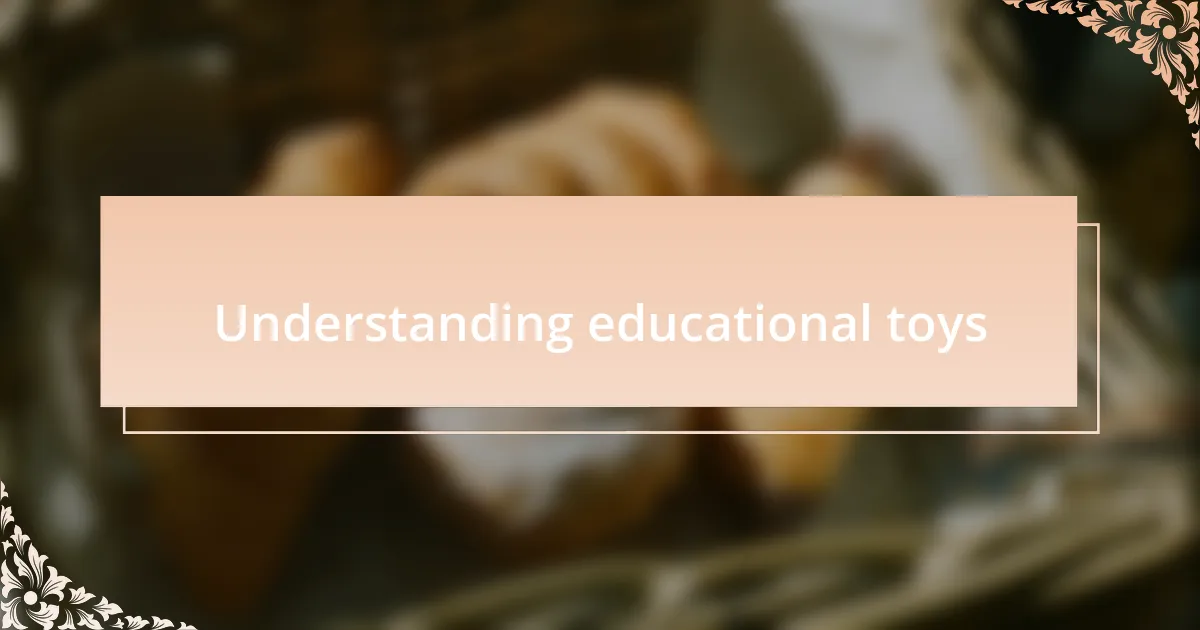
Understanding educational toys
Educational toys play a crucial role in a child’s development by stimulating their cognitive and creative skills. I remember watching my niece’s eyes light up as she pieced together her first puzzle; the look of accomplishment she wore was simply priceless. It made me realize that these toys do more than entertain; they nurture essential skills like problem-solving and critical thinking.
Moreover, the variety of educational toys can sometimes be overwhelming. Have you ever stood in the toy aisle, unsure which option best suits a child’s age and interest? I’ve been there, and it can be daunting. I learned to focus not only on the developmental goals but also on the interests of the child. For instance, my friend’s son loves animals, so we found him a toy that teaches about wildlife while encouraging imaginative play.
Another thing I came to understand is that educational toys should foster interaction and creativity. One of my favorite experiences involved working with my daughter on a building set. We spent hours constructing different structures, and those moments sparked her curiosity about engineering concepts. It highlighted how these toys can serve as a bridge to deeper conversations and learning opportunities, turning playtime into a true educational experience.
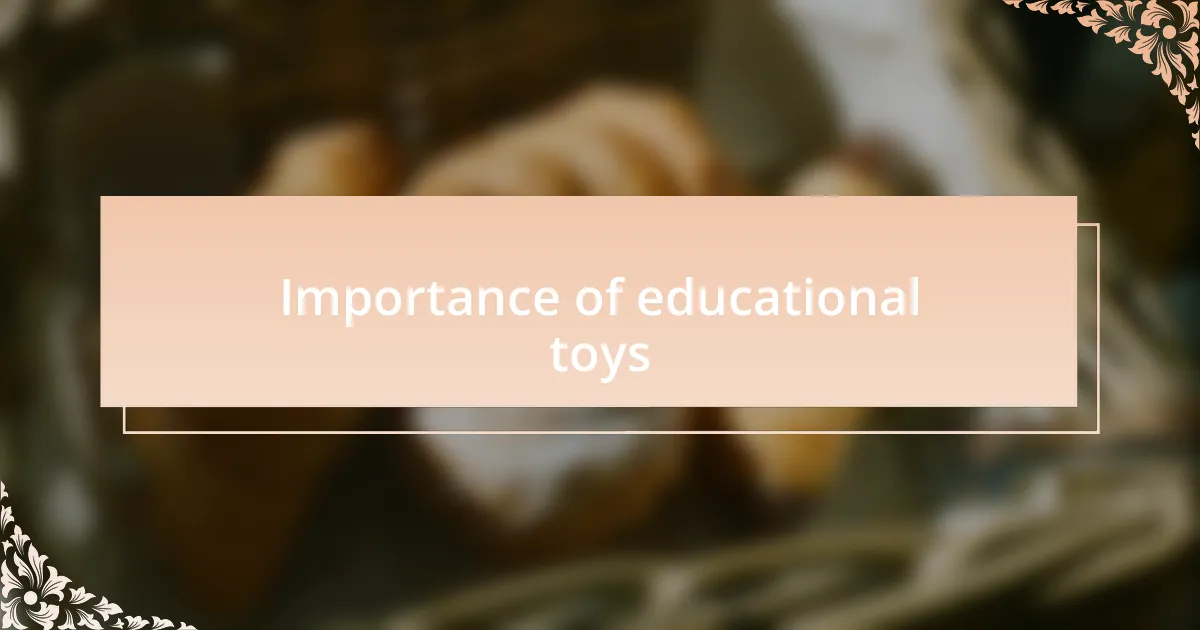
Importance of educational toys
When I think about the importance of educational toys, I remember the first time I introduced a science kit to my nephew. He had always been curious about how things worked, but empowering his curiosity with a hands-on experiment was a game-changer. Observing him mix various ingredients while wide-eyed with fascination made it clear that these toys could spark lifelong interests in subjects like science or math.
Additionally, educational toys serve as a powerful tool for social development. I recall hosting a playdate where kids interacted with a collaborative game that required teamwork to solve challenges. Watching them communicate, negotiate, and celebrate their successes opened my eyes to the social skills being honed through play. Isn’t it incredible how a simple game can teach empathy and collaboration?
There’s also the emotional aspect tied to these toys. One rainy afternoon, my daughter and I sat together with a learning tablet. As she solved problems and earned virtual rewards, I saw her confidence bloom. It was profound to witness how something so simple could help a child navigate her emotions, connecting effort with success. In my experience, educational toys aren’t just about learning; they’re about building resilience through play.
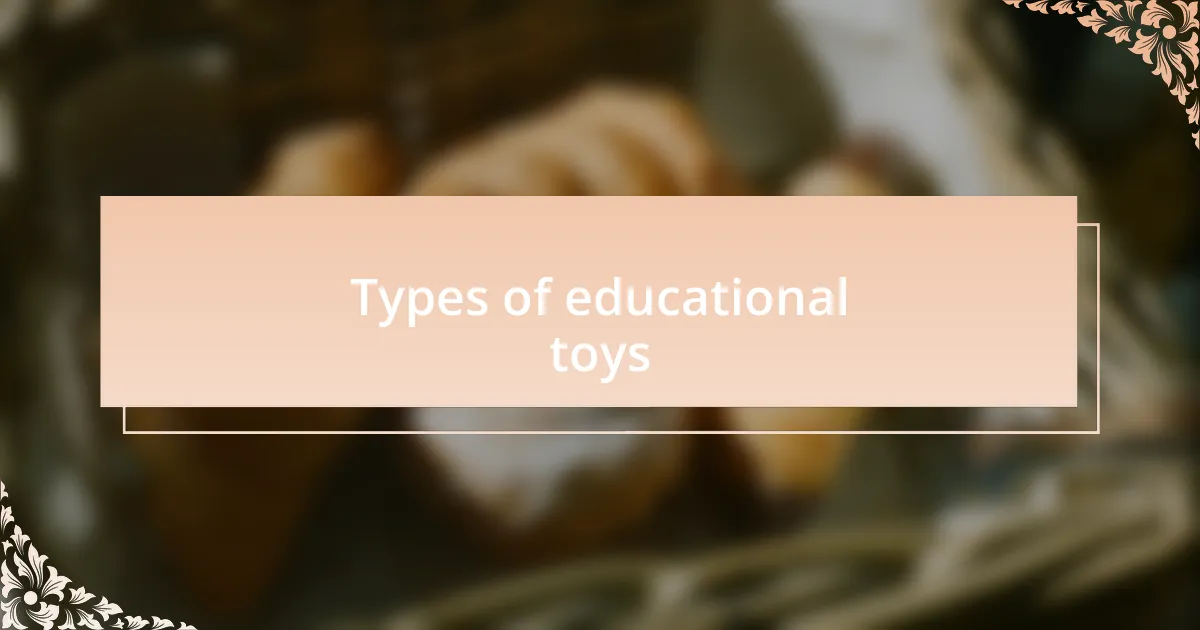
Types of educational toys
When it comes to educational toys, I’ve seen a wide variety that fulfills different learning needs. For instance, my daughter had a set of building blocks that not only promoted creativity but also introduced her to basic engineering principles. Each time she created a new structure, it felt like she was unlocking a tiny piece of the engineering world; isn’t it amazing how play can lay the groundwork for future skills?
Another type that has caught my attention is manipulative toys, like puzzles and tangrams. I remember spending hours with my son, piecing together colorful shapes, which not only sharpened his problem-solving abilities but also engaged his fine motor skills. The moment he fit that last piece into the puzzle was like witnessing a mini-celebration—it taught me the value of perseverance and the joy found in accomplishment.
Lastly, I can’t overlook the impact of interactive electronic toys. One memorable instance was when I gifted my niece a coding robot. Watching her program the robot to navigate a maze lit up her face with excitement! It was interesting to see how a simple toy could introduce complex concepts like coding in an enjoyable way. Have you ever thought about how these educational toys can shape the future of our children? It’s quite a journey through play and discovery.
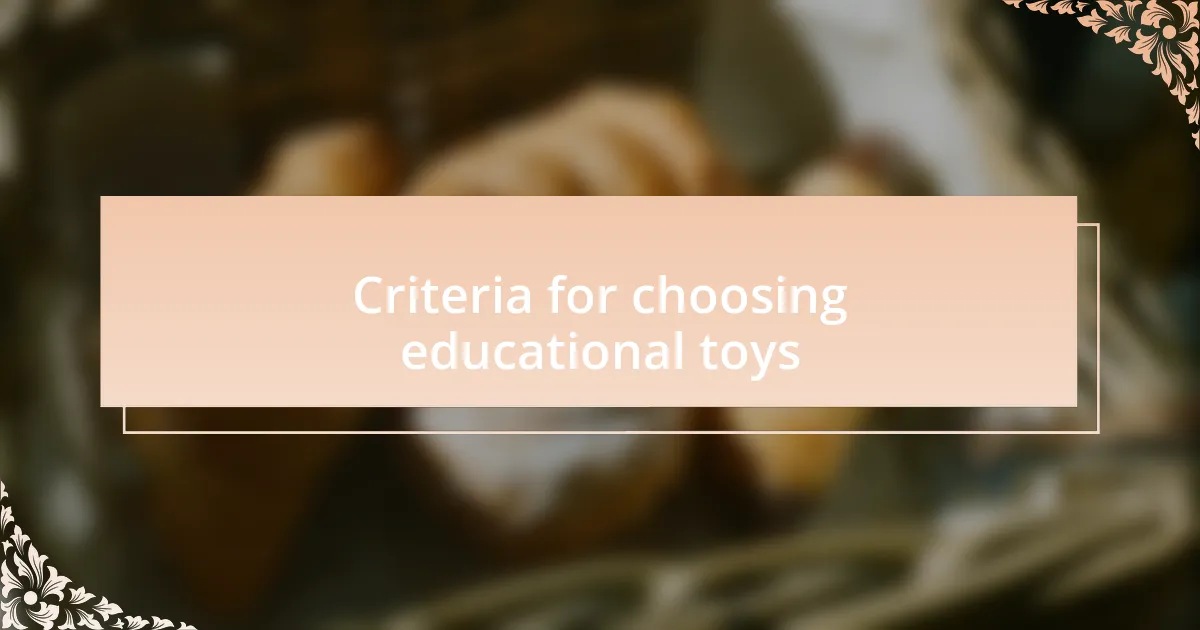
Criteria for choosing educational toys
When choosing educational toys, I always consider the age appropriateness of the toy. I remember buying a science kit for my son when he was still too young to grasp the concepts; it ended up collecting dust on the shelf. Selecting a toy that matches a child’s developmental stage ensures they can fully engage with it, making the learning experience both fun and effective.
Another important criterion is the toy’s ability to stimulate creativity and critical thinking. I once introduced my daughter to a simple art set, filled with various colors and mediums. Watching her explore and express herself through her artwork was a beautiful reminder that the right toy can unleash a child’s imaginative potential, pushing them to think outside the box.
Finally, I emphasize the importance of versatility in educational toys. Some of my daughter’s favorite toys are ones that can adapt to her growing skills, like a multi-functional game that teaches math but also incorporates logic puzzles. Isn’t it rewarding when a single toy can provide years of evolving educational experiences? It’s a testament to how thoughtful selections can grow alongside a child’s development.
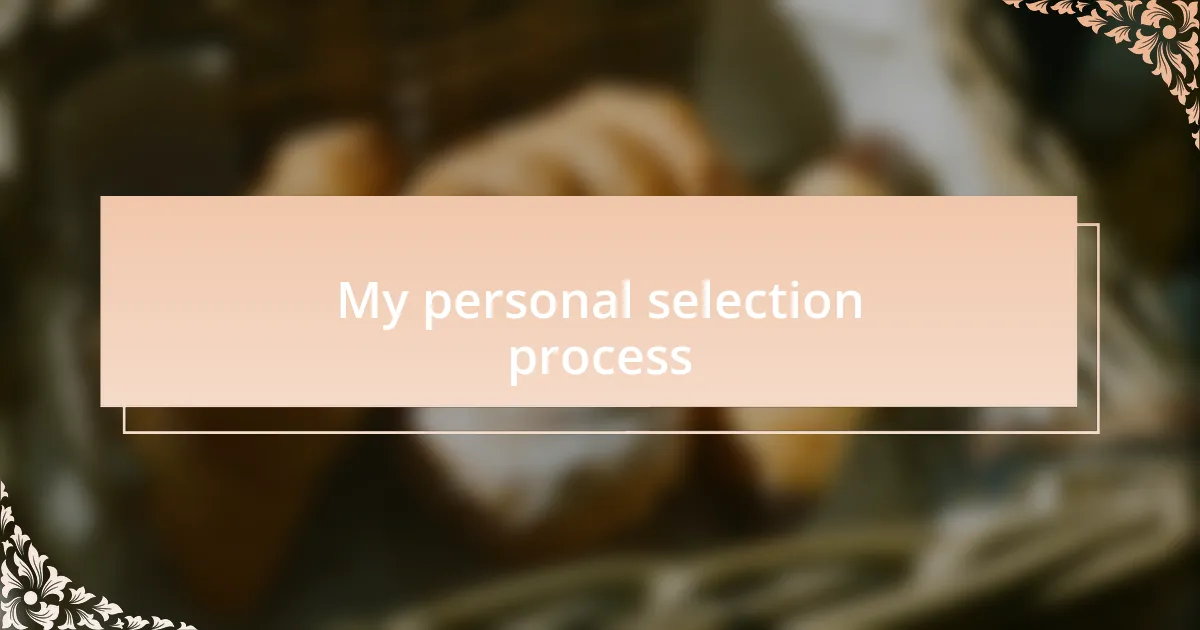
My personal selection process
When it comes to my personal selection process for educational toys, I rely heavily on hands-on experiences. I vividly recall the moment I chose a building block set for my son, not just because it seemed appealing but because I had seen how much he enjoyed constructing things with everyday objects around the house. It was exhilarating to see him transition from frustration to triumph as he pieced the blocks together, sparking endless hours of creativity.
I also pay close attention to the toy’s impact on my child’s social skills. One day, I decided to get a board game designed for teamwork. Initially, I had reservations—would my children cooperate, or would it end in chaos? I was pleasantly surprised at how the experience encouraged them to communicate and collaborate, reinforcing their bond while they navigated challenges together. These moments remind me that playtime can be a powerful tool for teaching valuable life skills.
Another key aspect of my selection process involves considering the educational value versus entertainment. For instance, I once found a robotic coding toy that looked like just another gadget, yet it promised an engaging way to learn coding fundamentals. I hesitated, wondering if it would really hold my child’s interest. To my delight, the toy sparked his curiosity and led to countless discussions about technology. As I reflect on these experiences, I can’t help but ask: isn’t it magical when learning feels like play?
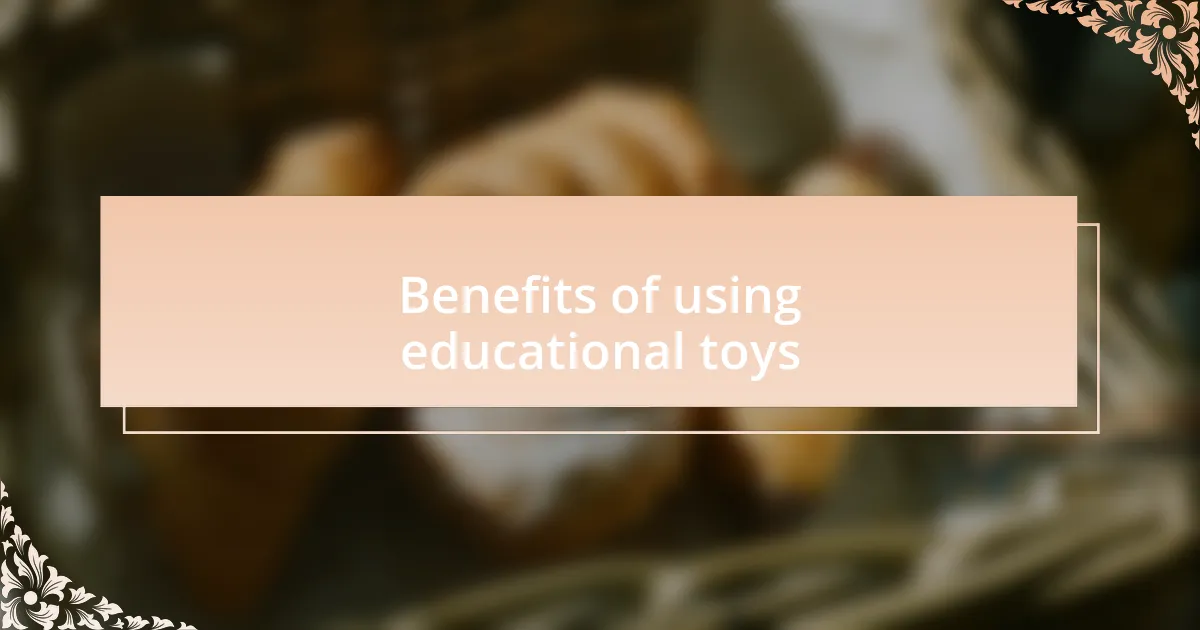
Benefits of using educational toys
Educational toys have a unique advantage in promoting cognitive development. I remember the first time my daughter explored a puzzle that challenged her spatial reasoning. As she rotated and manipulated the pieces, I could see her mind at work, problem-solving in real-time. It struck me how much these simple tasks could enhance her analytical skills while feeling like just playtime.
Another significant benefit is in fostering creativity. One winter afternoon, we dug out a set of art supplies that were labeled as educational. As we painted and crafted, I noticed my child’s imaginative world expand. The joy of creating something from scratch not only kept her engaged but also built her confidence in expressing herself. Isn’t it incredible how a few art supplies can unleash a child’s inner artist?
Additionally, educational toys often encourage independence and decision-making. I still cherish the day when my son built a fort using his blocks all on his own; I was thrilled to witness his thought process unfold. It was a beautiful moment of self-discovery, revealing how toys can help children learn to make choices and take initiative. Isn’t it remarkable how play can empower our kids to develop life skills?